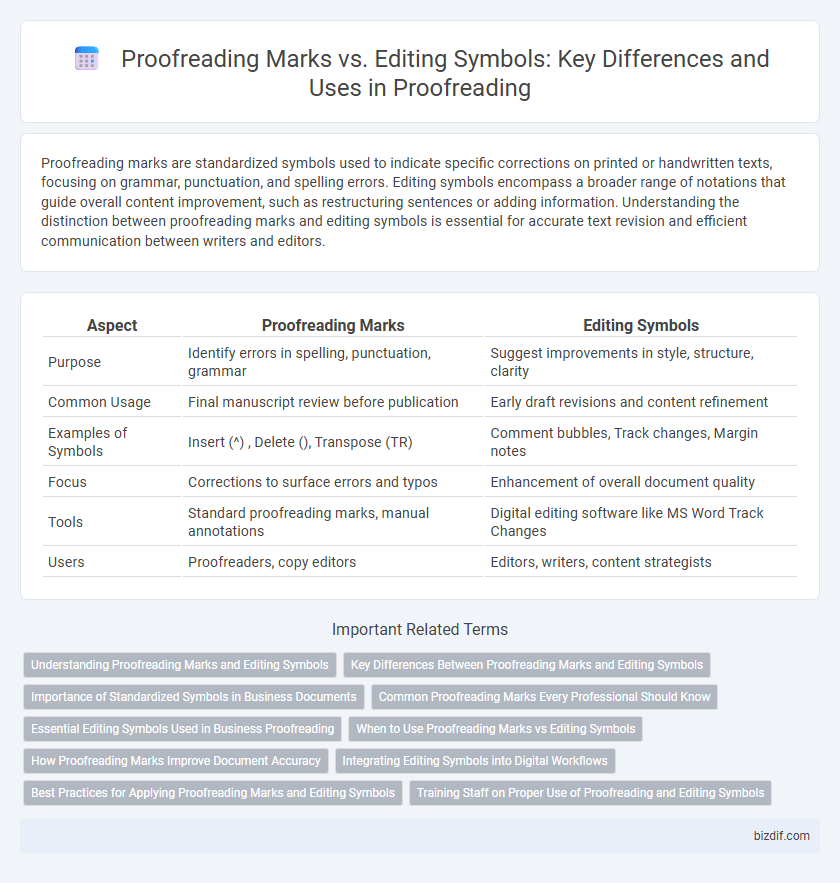Proofreading marks are standardized symbols used to indicate specific corrections on printed or handwritten texts, focusing on grammar, punctuation, and spelling errors. Editing symbols encompass a broader range of notations that guide overall content improvement, such as restructuring sentences or adding information. Understanding the distinction between proofreading marks and editing symbols is essential for accurate text revision and efficient communication between writers and editors.
Table of Comparison
| Aspect | Proofreading Marks | Editing Symbols |
|---|---|---|
| Purpose | Identify errors in spelling, punctuation, grammar | Suggest improvements in style, structure, clarity |
| Common Usage | Final manuscript review before publication | Early draft revisions and content refinement |
| Examples of Symbols | Insert (^) , Delete (), Transpose (TR) | Comment bubbles, Track changes, Margin notes |
| Focus | Corrections to surface errors and typos | Enhancement of overall document quality |
| Tools | Standard proofreading marks, manual annotations | Digital editing software like MS Word Track Changes |
| Users | Proofreaders, copy editors | Editors, writers, content strategists |
Understanding Proofreading Marks and Editing Symbols
Understanding proofreading marks and editing symbols is crucial for accurately identifying and correcting errors in written texts. Proofreading marks, such as insertions, deletions, and transpositions, specifically target surface-level mistakes in grammar, spelling, and punctuation, whereas editing symbols address broader changes like sentence restructuring, clarity, and style improvements. Mastery of these marks enhances communication between writers and editors, ensuring precise revisions and polished final documents.
Key Differences Between Proofreading Marks and Editing Symbols
Proofreading marks are standardized symbols used primarily to identify and correct surface errors such as spelling, punctuation, and grammar in a text, while editing symbols encompass a broader range of annotations including structural changes, content reorganization, and stylistic improvements. Proofreading marks focus on final-stage corrections to ensure text accuracy, whereas editing symbols address more comprehensive revisions during earlier editing phases. Understanding these key differences enhances effective communication between writers and editors to improve manuscript quality.
Importance of Standardized Symbols in Business Documents
Standardized proofreading marks and editing symbols ensure clear communication and consistency in revising business documents, reducing the risk of errors and misinterpretation. Consistent use of these symbols streamlines the editing process, saving time and improving document accuracy. Adopting universally recognized symbols supports professionalism and maintains the integrity of business communication.
Common Proofreading Marks Every Professional Should Know
Common proofreading marks every professional should know include symbols like the caret (^) for insertions, the deletion mark () for removing text, and the transpose mark (twisted loop) for switching letters or words. These marks provide clear, standardized instructions to improve text accuracy and readability during the editing process. Understanding and using these symbols effectively ensures efficient communication between writers and editors.
Essential Editing Symbols Used in Business Proofreading
Essential editing symbols used in business proofreading include the delete mark (a loop or a line through unwanted text), the insert caret (^) to add missing words or punctuation, and the transposition mark (two crossed lines) to switch words or letters. These proofreading marks ensure clarity and consistency in professional documents, facilitating precise communication between writers and editors. Mastery of standard symbols like these improves efficiency and accuracy in business document revisions.
When to Use Proofreading Marks vs Editing Symbols
Proofreading marks are best used during the final review stage to correct typographical errors, spelling mistakes, and minor formatting issues before publication. Editing symbols apply earlier in the writing process, guiding substantive changes like sentence structure, clarity, and content organization. Understanding the distinct purposes and timing of proofreading marks versus editing symbols ensures efficient and accurate manuscript revision.
How Proofreading Marks Improve Document Accuracy
Proofreading marks enhance document accuracy by providing clear, standardized indications for corrections, ensuring that errors in grammar, punctuation, and spelling are precisely identified and addressed. These marks facilitate effective communication between writers and editors, reducing misinterpretations and streamlining the revision process. Consistent use of proofreading marks minimizes overlooked mistakes, resulting in polished, error-free documents that maintain professional quality.
Integrating Editing Symbols into Digital Workflows
Integrating editing symbols into digital workflows enhances proofreading efficiency by enabling clear, standardized communication between writers and editors. Digital tools now support common proofreading marks such as insertions, deletions, and transpositions, allowing seamless annotation within text editors and collaborative platforms. This integration reduces errors, streamlines revisions, and accelerates the editing process in professional publishing and content creation environments.
Best Practices for Applying Proofreading Marks and Editing Symbols
Applying proofreading marks and editing symbols effectively requires clear understanding of each symbol's meaning to ensure precise communication between proofreaders and writers. Best practices include using standardized marks consistently, maintaining legibility, and applying them directly on the text or in the margins for easy reference. Combining these techniques enhances accuracy and streamlines the editing process across all written materials.
Training Staff on Proper Use of Proofreading and Editing Symbols
Training staff on the proper use of proofreading marks and editing symbols enhances accuracy and efficiency in document review processes. Clear understanding of standardized symbols such as insertions, deletions, and transpositions ensures consistent communication between writers and editors. Implementing regular workshops and reference guides helps reinforce correct symbol usage, reducing errors and improving overall text quality.
proofreading marks vs editing symbols Infographic

 bizdif.com
bizdif.com